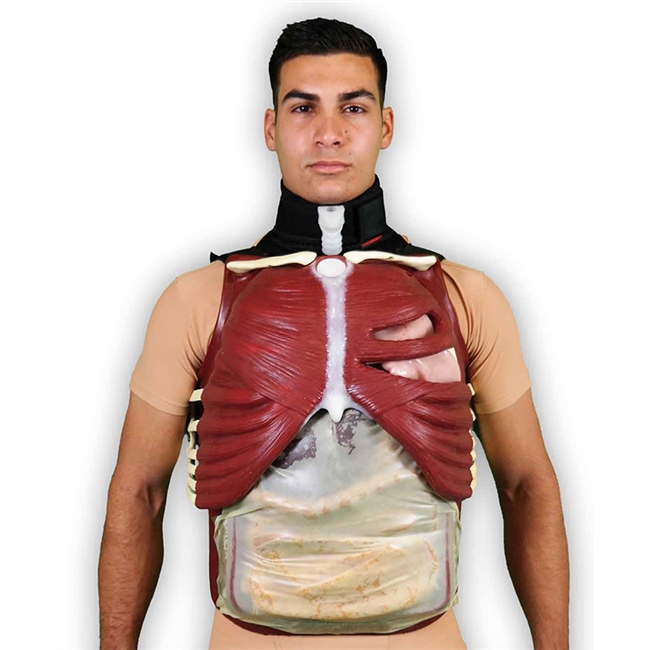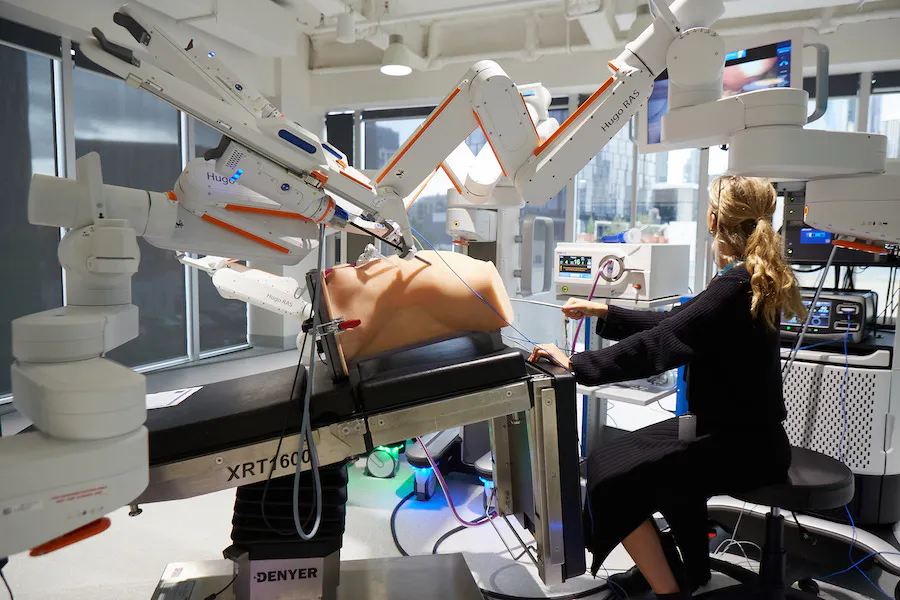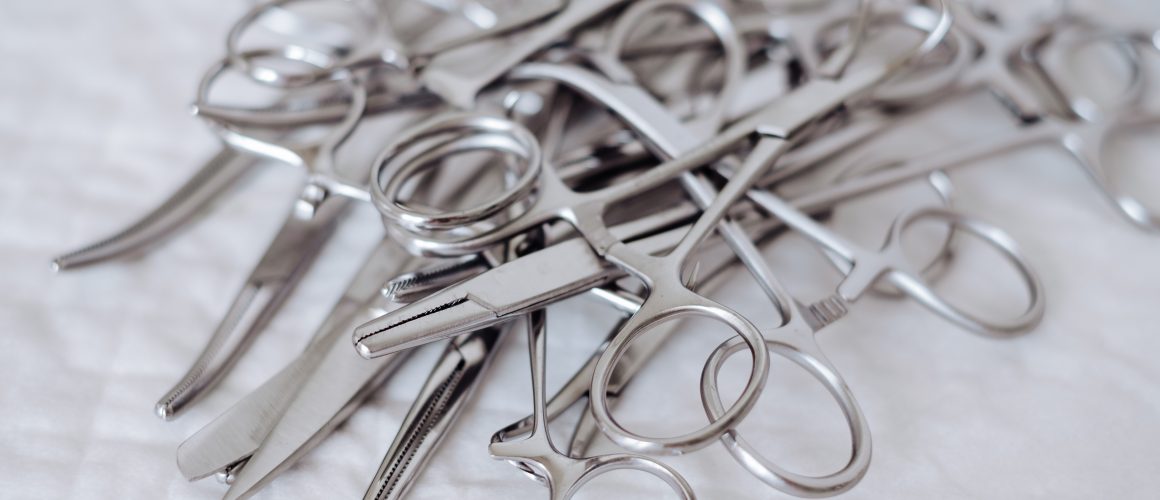In Australia, several surgical skills and trauma training courses for general surgeons and trauma surgeons exist and some of these courses involve the use of animals.
General surgeons train to perform various surgical procedures using various instruments, including scalpels, scissors and punch biopsies. Trauma surgeons specialise in treating medical emergencies and repairing injuries caused by blunt force or penetrating trauma.
Species of animals used in these courses are pigs, sheep, and in some cases chickens. The programs aim to provide hands-on experience to trainees in various surgical procedures, yet it is becoming increasingly clear that alternative training methods are superior to the use of animals in training.
Animal-based Surgical and Skills Training in Australia
The Alfred Hospital, Melbourne where Extracorporeal Membrane Oxygenation (ECMO) courses are conducted on live pigs through simulation techniques and hands-on practice of inserting wide bore cannulae (tubes) into the major arteries and veins in the leg and neck of pigs. Documents released under Freedom of Information to HRA show that approximately 80 pigs are used each year.
South Australian Health and Medical Research Institute (SAHMRI) Gilles Plains, Adelaide. The School of Anatomy has a range of surgical workshops in a range of fields, including trauma, cardiology, gynaecology, ear, nose and throat and device testing with a “supply of Direct supply of research sheep, mice and rats (SAHMRI-Bioresources)”
Vasculab, Parkville, Victoria where live animals and cadavers are used in angiographic (a medical imaging technique) procedures and other areas of surgery including trauma, orthopaedic, spine, general and laparoscopic and the Definitive Surgical Trauma Care courses.
The Definitive Surgical Trauma Care (DSTC) course is recommended by The Royal Australasian College of Surgeons for all Consultant Surgeons and final-year trainees and is carried out at various locations around Australia*.
Royal Prince Alfred Institute of Academic Surgery – Surgical and Robotic Training Institute, NSW. Around 100 pigs each year are used for training courses. The Surgical and Robotic Training Institute has started using anatomical training models from Intuitive Surgical to train surgeons. These anatomical training models consist of fresh frozen bovine and porcine tissue.
Medical Engineering Research Facility, at the Prince Charles Hospital, Queensland
Clinical Skills Development Service Queensland Government
Clinical Training and Evaluation Centre (CTEC) Perth, WA.
Trauma Training
In a 2017 letter to HRA, the Royal Australasian College of Surgeons (RACS) announced that it will phase out the use of live animals for its Early Management of Severe Trauma (EMST) programme by 2018.
The programme trains physicians and Australian Defence Force (ADF) medical officers on treating traumatic injuries. After looking into advanced human-simulation technology, then RACS President Philip Truskett confirmed that EMST participants in RACS courses will no longer use live animals in training. Up until this time, training involved cutting holes into the throats, chests, and limbs of live animals including dogs and pigs.
However, an advanced trauma course recommended by RACS continues to use animals. The Definitive Surgical Trauma Care (DSTC) course is recommended by RACS for all consultant surgeons and final-year trainees. It is an intensive 3-day course in which animals are used for advanced surgical skills training for trauma cases.
Procedures covered during DSTC can instead be taught on human cadavers (dead human bodies donated for medical use) and advanced human patient simulators, as is already being done in the UK’s version of the DSTC (Royal College of Surgeons of England) and the American College of Surgeons’ Advanced Surgical Skills for Exposure in Trauma course. Military and civilian studies have found that non-animal methods better equip trainees with the technical skills and psychological preparedness necessary to treat traumatic injuries.

Legislation
The Australian Code for the Care and Use of Animals for Scientific Purposes (2013) at S1.19, states:
Replacement: Before the use of animals is considered, all existing information relevant to the proposed aim(s), including existing databases, must be examined. Replacement techniques that must be considered include the use of epidemiological data; physical and chemical analysis; computer, mathematical and inanimate synthetic models; simulations; in vitro systems; non-sentient organisms; cadavers; and clinical cases.
Australian Code for the Care and Use of Animals for Scientific Purposes (2013)
Every institution which uses animals in surgical or trauma training must obtain approval from an animal ethics committee (AEC). AECs should not approve animal use where valid alternatives exist.
RACS Position
The Royal College of Surgeons (RACS) robot-assisted surgery working group released its final report and recommendations in June 2023.
“RACS acknowledges the ethical and financial considerations of using cadavers and live animals in training and the limitations in some instances of synthetic inanimate models, RACS acknowledges these models do allow surgeons to develop familiarity and dexterity in performing manoeuvres.
RACS recommend a staged simulation training pathway. We have defined the simulation training pathway as:
Stage 1. Virtual reality simulation; incorporating all computer-based and virtual reality simulation exercises
Stage 2. Basic exercise-based simulation; basic surgical simulation which does not use biological tissues (living or dead)
Stage 3. High-fidelity laboratory; advanced surgical simulated environment which closely replicates the operative environment as much as functionally possible through use of high-fidelity models including cadaveric, animal and/or synthetic materials
Note: Although high-fidelity laboratory implies the use of biological tissue, including animals and cadavers, however we also endorse the use of synthetic models. If a feasible and equivalent alternative to non-human animal tissue exists its use is encouraged wherever possible.”
Non-animal Replacements for Trauma Skills Training
Simulators
TraumaMan® System is a popular tool designed specifically for this training that replicates a breathing, bleeding human torso, complete with realistic layers of skin and tissue, ribs and internal organs. It has lungs that breathe and even bleeds when cut. Human simulators have been approved internationally since 2001 as full replacements for animal use. The TraumaMan® System is the most widely used surgical simulator in the world. Syndaver produces a range of simulators models for surgical training.
Medical Simulation products are also available from Stategic Operations who provide a range of medical simulation products and situations that bring realism to military and first responder training. For examples of products include the Human Worn Partial Task Surgical Simulator (“cut suit”) is a realistic way to simulate the look, feel and smell effects of severe traumatic events on a live human. It allows physicians to safely perform real procedures from the point of injury to the treatment enroute and transition of care to surgical intervention.

Credit: Strategic Opreations
International Medical Robotics Academy
Some organisations such as IMRA, a centre of excellence that embraces new technology, based in Melbourne, have been able to adapt to the changing education needs of modern surgeons and deliver state-of-the-art robotic surgical training through a curriculum using online education, virtual reality, 3D video, simulators, and advanced synthetic organ models. IMRA uses synthetic models and virtual reality.
Examples of lifelike synthetic models can be found here.
“These synthetic models reduce then eliminate the need for cadavers and animals via lifelike synthetic organs that can be created on demand to simulate both normal and diseased conditions.” – IMRA
Listen to AFSA’s podcast episode with Andrew Costello of IMRA.

The Hugo RAS (robotic assisted surgery) system
Credit: International Medical Robotics Academy (IMRA)
Macquarie University Hospital
In 2021 leading private teaching hospital, Macquarie University Hospital, Sydney, launched CMR Surgical’s Versius ® surgical robotic system for a range of laparoscopic procedures.
“The arrival of Versius opens the door for hospitals and surgeons to be able to access this cutting-edge technology, helping them to deliver the best surgical care possible.” – Per Vegard Nerseth, Chief Executive Officer of CMR

Robotics
Robotics is a modality for performing skills but not always an alternative to using animals for skills training. Indeed, it must be recognised that much robotics training in Australia and around the world is conducted on live animals.
Where it can be used, robotics without the use of animals offers a more ethical, reproducible, customisable, cost-effective, and technologically advanced alternative to animal-based surgical training leading to a shift towards more humane and effective training methods in surgical education.
Yet it is still a long way from being widely practiced in Australia with less than a handful of institutes in Australia having a robot. Typically, robotics training is something that surgeons undertake after they have completed surgical training.
The advantages are summarised below:
- Ethical considerations: Many people find it morally objectionable to use animals for training purposes when alternative methods are available.
- Reduced harm: Animal-based surgical training typically requires the euthanisation of animals after surgery or the use of animals that may suffer during the procedures.
- Reproducibility: Robotic surgical training offers a more controlled and reproducible learning environment. Surgical skills can be honed in a consistent and standardized manner, ensuring that all trainees receive the same training experience. Trainers can create various surgical scenarios and complications, allowing trainees to practice a wide range of skills and scenarios preparing surgeons for real-world challenges.
- Reduced cost: While the initial investment in robotic surgical training equipment may be high, it can ultimately be more cost-effective than maintaining animals for surgical training purposes over the long term.
- Infection control and safety: Robotic surgical training eliminates the risk of disease transmission between animals and humans.
- Availability and convenience: Robotic surgical training systems are more readily available and accessible than live animals, making it easier for medical institutions and surgeons to incorporate them into their training programs. No Animal Ethics Approval is required. Training can be conducted remotely allowing trainees to practice and refine their skills without being limited by the availability of live animals or the need to travel to specialised facilities.
- Advances in technology: Robotic surgical training systems continue to advance, incorporating cutting-edge technology such as virtual reality, haptic feedback, and artificial intelligence
Cadavers and Synthetic Models
An uptake of skills training using cadavers and synthetic models is urgently sought. Unfortunately, there is a lack of quality synthetic models for open surgery (traditional type of surgery in which an incision is made using a scalpel) although there is little evidence that practicing open surgery on animals makes for better technical skills, which are finessed through performing human surgery. There are, however, synthetic models for simple open procedures (such as performing skin excisions).
It is widely recognised that perfused human cadavers (preserving the cadaver by treatment with special chemicals, i.e. embalming, to increase the authenticity of surgical simulation) are superior to animal models from an educational perspective.
However, the issue is one of cost especially in Australia where cadavers, let alone soft-embalmed cadavers necessary for perfusion, are particularly expensive compared to Europe and North America. Another factor is the lack of donors.
Body donation is a unique gift, but unlike organ donation, in Australia, there is no single register for body donation. Instead, there are several universities across Australia where one can donate their body for science and education. To apply, contact needs to be made with the University directly. A list of universities across Australia, with links and direct phone numbers to their body donation programs can be found at this helpful resource produced by Willed.
Of course, donating your body to science and education is a sensitive issue – not only a personal decision but one that will affect the whole family. It is strongly recommended that the intention be discussed with family members.
Fusetec is an advanced Adelaide-based manufacturing medical training device company specialising in anatomically accurate, surgical training models using 3D technologies.
Dr Kerry Foley, a retired emergency medical doctor who volunteers for the Physicians Committee for Responsible Medicine, shares her views on best practices for surgical training and why those do not include using animals. Listen here.

New Developments
Other models are under development in Australia. In her research Replacing porcine and ovine animal training models with advanced simulators for life-saving ECMO implantation training, Rezan Jafary of Monash University has undertaken research developing simulators that mimic the tactility of the skin, fat muscle and vessels as well as the ultrasound properties of biological tissue. Her study aims to evaluate the suitability of simulators as a reliable alternative to animal tissue for ECMO training. Unfortunately, however, at this stage, this research has not eliminated the use of animals in ECMO training at the Alfred Hospital.
For Students
Historically life and health sciences education has used animals for teaching. However there are now thousands of humane educational alternatives available at all academic levels and disciplines. Humane Learning Info provides resources to guide and assist students who wish to conscientiously object to harmful animal use in their education.
InterNICHE, the International Network for Humane Education, is an excellent resource offering a powerful repository of resources for high-quality, fully humane education and training in medicine, veterinary medicine, and biological science. It aims to meet the needs of teachers and trainers, students, ethics committees and campaigners internationally.
Further Reading
Gower EW et al. (2023) The impact of incorporating surgical simulation into
trichiasis surgery training on operative aspects of initial live-training surgeries. PLoS Negl Trop Dis 17(4): e0011125.
Costello, D. et al (2021) A review of simulation training and new 3D computer-generated synthetic organs for robotic surgery education. Journal of Robotic Surgery
Vartner, C. et al (2021) The Past, Present and Future: A discussion of Cadaver Use in Medical and Veterinary Education
Devoto, L. et al (2019) Highly Accurate, Patient-Specific, 3-Dimensional Mixed-Reality Model Creation for Surgical Training and Decision Making JAMA Surg. 2019;154(10):968-969. doi:10.1001/jamasurg.2019.2546
